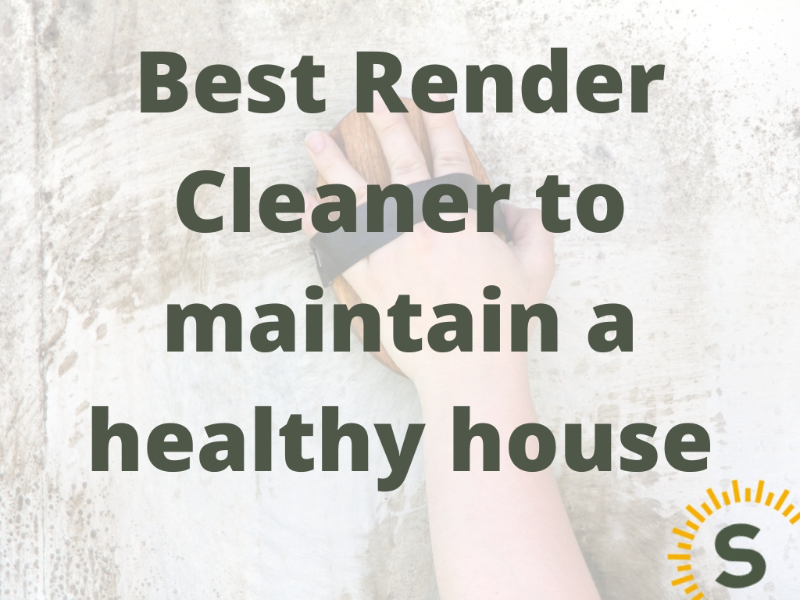
In the quest to maintain a well-presented home, knowing how to clean your render effectively is essential. This insight explores the best render cleaners, their applications, and the detailed methods to clean various types of render.
Render, an exterior finish applied to buildings, can lose its charm due to exposure to weather conditions, leading to the growth of algae, mould, and fungi. This necessitates the use of the best render cleaner to maintain the aesthetic appeal of the property.
Using the right cleaning methods and chemicals, you can prevent damage to the render, avoid unnecessary re-rendering, and prolong the lifespan of your rendered surfaces.
Preventive maintenance and regular cleaning of render can save you money in the long-term, reducing the risk of costly repairs or replacements. Over time, render can become discoloured due to dirt, algae, mould, and other environmental factors. Regular cleaning helps to maintain the original colour and prevent damage to the render.
For the longevity of your rendered area, regular maintenance is crucial. This involves periodic cleaning every 6-12 months. Regular upkeep can prevent the need for harsh and dangerous solvents or acid-based cleaners on the surface of the render.
When selecting the best render cleaner, it's crucial to consider the type of render you have and the level of staining or algae growth. Detergents, biocides, and fungicides are commonly used to clean render and remove algae growth.
For minor algae growth, a detergent with a light brush can suffice. However, for more severe cases, it's advisable to employ professional render cleaning services.
Floorseal's Professional Quality Render Cleaner is a powerful and effective cleaning agent designed to remove green algae, red algae, and black lichens from any type of render or masonry. It can be diluted or used neat, making it suitable for both professionals and DIYers. Apply it with a pump-up sprayer or brush, keep it wet for 15 minutes or more, and see rapid results! This versatile cleaner works on various surfaces like render, stone, brick, tiles, and concrete.
Floorseal should be applied to a dry surface whenever possible. On a very hot day, especially on an elevation facing the sun, it can be beneficial to hose down the surface to cool it. This minimises the possibility of the biocide "boiling-off" before it can work.
Using the best render cleaner and the right techniques, you can maintain the look of your property and prolong the life of your render. Regular maintenance and professional cleaning services can ensure your render stays in top condition for years to come.
To apply the render cleaner correctly, use a pump up spray such as the spear & jackson sprayer below.
Professional render cleaning services, begin with an evaluation of the render and the staining found on it. They then choose the correct methods and cleaning solutions for your building. If the algae growth is low, a simple biocide application may be enough. For black mould stains, they would softwash the render using detergent, followed by a steam clean at low pressure.
Sometimes, re-rendering becomes necessary, especially when the render damage has been extensive. Patch repairs can look out of place and are generally not recommended unless absolutely necessary.
Hand cleaning is a simple yet effective method for cleaning render. Scrubbing the surface with a stiff broom and hosing it down can prevent the formation of dry grime and residue.
If you prefer to use a pressure cleaner, it's important to use a fan tip and maintain a spray pressure of 80-120Psi to avoid damaging the rendered finish.
Most generic household cleaners are safe for general cleaning of render. Products like CCS Citric Cleaner are effective in removing grease, oil, and efflorescence. For rust stains, CLR Cleaner is recommended.
Mould and mildew often grow in areas with high levels of humidity or where water leaks occur. To handle this, apply a residual fungicidal wash like Acryloc Mould Rid, which remains on the surface and kills mould as it hatches from the spores.
Understanding the type of render to be cleaned is essential for choosing the most effective treatment system. Different techniques are used to soft wash various types of render.
Rinsing is an essential part of the render cleaning process. It ensures the salts left behind by the breakdown of chlorine, which could leave stains if not rinsed properly, are removed.
Pressure washing render can be a controversial topic, and the decision to do so depends on the condition of the render and proper precautions taken. Pressure washing can effectively remove dirt, algae, and grime from the surface, restoring the render's appearance. However, there are potential risks associated with pressure washing:
If you choose to pressure wash render, consider the following precautions:
Ultimately, pressure washing render can be effective if done carefully and with the proper precautions. However, if you are uncertain or worried about potential risks, it's safer to opt for alternative cleaning methods or seek professional assistance.
Read More:
Helpful Sources:

Stuart is an expert in Property, Money, Banking & Finance, having worked in retail and investment banking for 10+ years before founding Sunny Avenue. Stuart has spent his career studying finance. He holds qualifications in financial studies, mortgage advice & practice, banking operations, dealing & financial markets, derivatives, securities & investments.





Our website offers information about financial products such as investing, savings, equity release, mortgages, and insurance. None of the information on Sunny Avenue constitutes personal advice. Sunny Avenue does not offer any of these services directly and we only act as a directory service to connect you to the experts. If you require further information to proceed you will need to request advice, for example from the financial advisers listed. If you decide to invest, read the important investment notes provided first, decide how to proceed on your own basis, and remember that investments can go up and down in value, so you could get back less than you put in.
Think carefully before securing debts against your home. A mortgage is a loan secured on your home, which you could lose if you do not keep up your mortgage payments. Check that any mortgage will meet your needs if you want to move or sell your home or you want your family to inherit it. If you are in any doubt, seek independent advice.